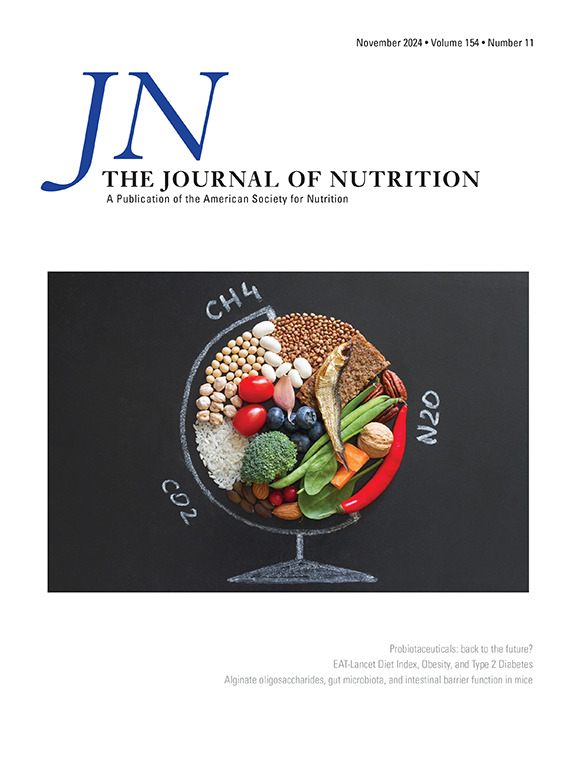Protein Biomarkers of Ultra-Processed Food Consumption and Risk of Coronary Heart Disease, Chronic Kidney Disease, and All-Cause Mortality
IF 3.7
3区 医学
Q2 NUTRITION & DIETETICS
引用次数: 0
Abstract
Background
There is a need to understand the underlying biological mechanisms through which ultra-processed foods negatively affect health. Proteomics offers a valuable tool with which to examine different aspects of ultra-processed foods and their impact on health.
Objectives
The aim of this study was to identify protein biomarkers of usual ultra-processed food consumption and assess their relation to the incidence of coronary heart disease (CHD), chronic kidney disease (CKD), and all-cause mortality risk.
Methods
A total of 9361 participants from the Atherosclerosis Risk in Communities visit 3 (1993–1995) were included. Dietary intake was assessed using a 66-item food-frequency questionnaire and the processing levels were categorized on the basis of the Nova classification. Plasma proteins were detected using an aptamer-based proteomic assay. We used multivariable linear regressions to examine the association between ultra-processed food and proteins, and Cox proportional hazard models to identify associations between ultra-processed food-related proteins and health outcomes. Models extensively controlled for sociodemographic characteristics, health behaviors, and clinical factors.
Results
Eight proteins (6 positive, 2 negative) were identified as significantly associated with ultra-processed food consumption. Over a median follow-up of 22 y, there were 1276, 3084, and 5127 cases of CHD, CKD, and death, respectively. Three, 5, and 3 ultra-processed food-related proteins were associated with each outcome, respectively. One protein (β-glucuronidase) was significantly associated with a higher risk of all 3 outcomes, and 3 proteins (receptor-type tyrosine-protein phosphatase U, C-C motif chemokine 25, and twisted gastrulation protein homolog 1) were associated with a higher risk of 2 outcomes.
Conclusions
We identified a panel of protein biomarkers that were significantly associated with ultra-processed food consumption. These proteins may be considered potential biomarkers for ultra-processed food intake and may elucidate the biological processes through which ultra-processed foods impact health outcomes.
超加工食品摄入的蛋白质生物标志物与冠心病、慢性肾病和全因死亡率的风险
背景:有必要了解超加工食品对健康产生负面影响的潜在生物机制。蛋白质组学为研究超标加工食品的不同方面及其对健康的影响提供了宝贵的工具:目的:确定通常食用超加工食品的蛋白质生物标志物,并评估它们与冠心病、慢性肾病发病率和全因死亡风险的关系:方法:共纳入 9361 名社区动脉粥样硬化风险(ARIC)第 3 次访问(1993-1995 年)的参与者。采用 66 项食物频率问卷评估膳食摄入量,并根据 Nova 分类法对加工程度进行分类。血浆蛋白质采用一种基于适配体的蛋白质组测定法进行检测。我们使用多变量线性回归来研究超标加工食品与蛋白质之间的关系,并使用 Cox 比例危险模型来确定超标加工食品相关蛋白质与健康结果之间的关系。模型广泛控制了社会人口特征、健康行为和临床因素:结果:共发现 8 种蛋白质(6 种为阳性,2 种为阴性)与超标加工食品消费有显著相关性。在中位 22 年的随访中,冠心病、慢性肾病和死亡病例分别为 1 276 例、3 084 例和 5 127 例。每种结果分别与三种、五种和三种超加工食品相关蛋白质有关。一种蛋白质(β-葡萄糖醛酸酶)与三种结果的较高风险显著相关,三种蛋白质(受体型酪氨酸蛋白磷酸酶U、C-C motif趋化因子25和扭转胚胎蛋白同源物1)与两种结果的较高风险相关:我们发现了一组与超加工食品消费显著相关的蛋白质生物标志物。这些蛋白质可被视为超加工食品摄入量的潜在生物标志物,并可阐明超加工食品影响健康结果的生物过程。
本文章由计算机程序翻译,如有差异,请以英文原文为准。
求助全文
约1分钟内获得全文
求助全文
来源期刊

Journal of Nutrition
医学-营养学
CiteScore
7.60
自引率
4.80%
发文量
260
审稿时长
39 days
期刊介绍:
The Journal of Nutrition (JN/J Nutr) publishes peer-reviewed original research papers covering all aspects of experimental nutrition in humans and other animal species; special articles such as reviews and biographies of prominent nutrition scientists; and issues, opinions, and commentaries on controversial issues in nutrition. Supplements are frequently published to provide extended discussion of topics of special interest.
 求助内容:
求助内容: 应助结果提醒方式:
应助结果提醒方式:


